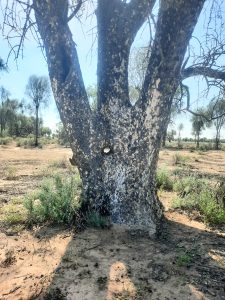I don’t know the Gomeroi name for water holding trees but am hoping Rhonda Ashby can find out for me as she is the language expert (gamilaraay/ yuwaalaraay/ yuwaalayaay). In the Menang language group of the south western Noongar people in W.A they are called Gnaama Boorna (Gnaama = a hole for water & Boorna = tree) The climate over on Noongar country is much cooler & wetter than here so I expect the Gnaama Boorna were filled more often & the water lasted longer. I saw a small box tree with water in it back in 2016 (below) but didn’t pay much attention at the time.

Then about a week ago now I was moving sheep through our southernmost farming paddock and noticed some small leopardwood ringtrees. Ringtrees indicate reliable water here but there is none that I know of around this place. The paddock (known as “Antigar” – meaning something I cant repeat) is mostly cultivated so there is only a fringe of remnant vegetation remaining. I assumed the leopardwood rings may have been indicating natural water in the neighbouring property over the boundary fence.


Ive seen a few ringtrees here that puzzled me as they don’t seem water related – like this unique & stunning example below.

When you move/ drive sheep in summer here you have all the time in the world to rubberneck trees as you are travelling at the same pace as the sheep. I would go so far as to say without sheep, the treasure trove of thousands of CMT pics featured on this website for your viewing pleasure, wouldn’t exist. Only quiet cattle move slowly and we have mad wagyu that play all sorts of feral tricks in the sandhills & scrub. Allan Tighe used to train racehorses in town but he reckoned the wagyu would leave them for dead in the Gingie Gallop at the Ridge over Easter. Allo and I really looked at the trees because we both followed mobs of sheep – SLOWLY. We didn’t sit scrolling thru our phones to find something better to watch on Utube /TiKToK. People call it mindfulness but I think it’s more mindlessness – meandering in a dust haze watching trees. As Ive come to realise, some of them are watching you back …
So to cut a long story short – a story that’s runs for millennia, but modern humans have an attention span of about 5 mins max – here is the first ever non eucalypt wood well ever recorded. The reason I know it’s a well tree/ water holding tree is … ITS HOLDING WATER !!!! 


After 10 days since the last storm at an ave. summer day temps of 35 C – its still holding water. This well tree is a whitewood – Atalaya hemiglauca – birraa and you can see the lumps on the side of the scar – they are caused by stone axe cuts. I think I can see stone axe cuts inside the trunk /wood well but I haven’t been back to Antigar since so I cant be sure. I stuck my hand inside the birraa well and felt mud at the bottom but I will wait for Priscilla or Rhonda to check it out further.
Another interesting tree I found recently over on wailwun country is this huge belah TinT in the Ginghet reserve just off Billybingbone rd. As you can see the host eucalypt has been pared down with a steel axe so it looks like a wooden urn.



Like here on gomilaroi land there are belah (Casuarina cristata) trees in this place too that have been rung (girdled). Nobody knows anything about the practise but Ive always assumed that it must have been wrought by a new recruit to the Chinese ringbarking team that couldnt tell a belar from the target species, normally coolabah. Here are some examples below



My 87 yr old mother thinks they (i.e white ancestors) rung belah trees so more grass would grow in the swamps but my 70 yr old husband doesn’t think they did. I would love some more information on the humble belah tree if anyone knows anything? Although not beautiful as such, they are the consummate all-rounder of the CMT world. The belah timber was used for spears and the branches can be inosculated into rings when young. Dead belahs make excellent firewood and they can act as both guests and hosts in TinTs. Tree species have different timber qualities, so they form scars in different ways. The most common visible scar by far out here is on the bimble/ poplar box. Coolabahs still carry big scars but many of the smaller wounds have healed over time. Unless the coolabah tree was rung and killed more than a century ago most of their coolamon scars have healed over now. Such is life.
